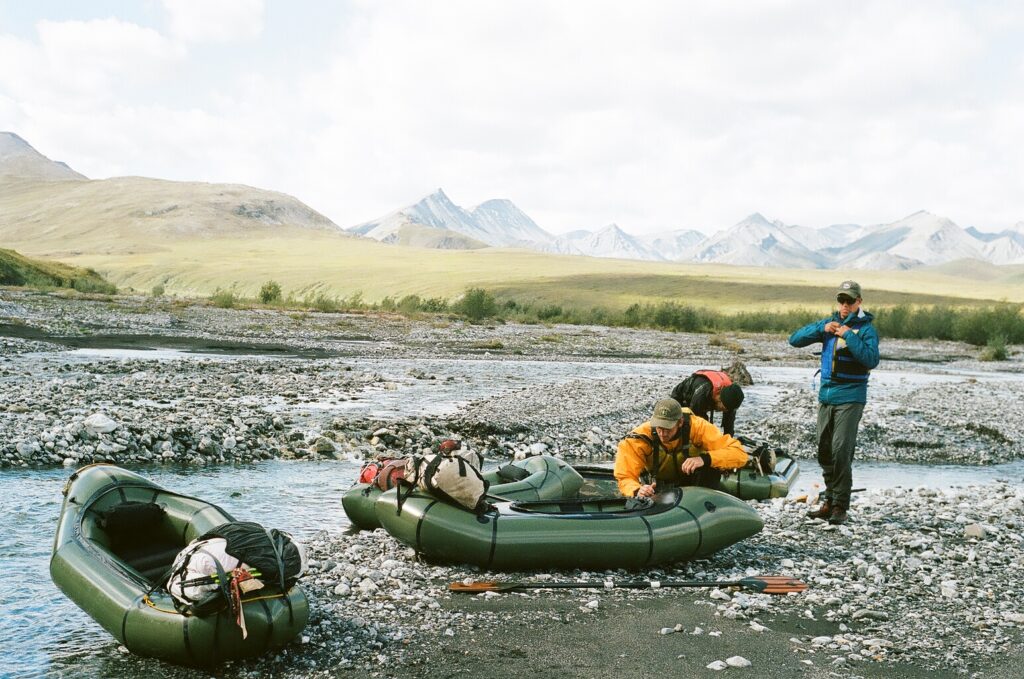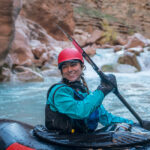We caught up with Ambassador Molly Harrison on her experience in the Arctic National Wildlife Refuge – and how you can help to protect this landscape!
Your prior work in environmental conservation has been one of your motivations for plunging deeper in outdoor recreation. How does that inform the time you spend in the outdoors?
My love for specific landscapes and my sense of place has developed hand-in-hand with my work in environmental conservation. I’ve always enjoyed outdoor recreation, but it wasn’t until I started working in public lands conservation that I realized how deeply you can feel connected to a landscape. I spent entire seasons working along short sections of riparian corridors, forests, and canyons – where I felt that by the end of the season I knew the landscape intimately. This is in stark contrast to how I generally spend time in the outdoors; whether hiking, boating, biking or climbing, these activities move me through a landscape fairly quickly. Spending a prolonged amount of time in just one place and pouring hard effort into protecting it gave me a deeper appreciation for what a place can mean to someone.
Conservation work also taught me a whole new set of manual labor and outdoor lifestyle skills that I don’t think I would have discovered otherwise. Transitioning from academia to learning how to run a chainsaw for a living was like landing on another planet – everything I was doing I was learning for the first time. I think learning a completely new skillset is something that doesn’t happen enough to us as adults, and it really pushed me out of my comfort zone in the best ways possible. This work made me a more confident and independent person, and that has directly correlated to pushing myself to try new things in the outdoors.

Your upcoming packrafting expedition is to the 1002 Coastal Plains of the Arctic National Wildlife Refuge (ANWR), an area currently threatened by oil and gas development. How did you become involved in this issue and why is this something you want to highlight?
In the summer of 2017, four friends and I traveled to the Refuge for a packrafting/backpacking trip along the Ivishak River. It was truly the trip of a lifetime – we had perfect weather, amazing scenery, exciting wildlife encounters, and it offered the chance to travel through one of the most remote areas in the United States. I came away from that trip hardly believing such a place existed, it’s that powerful. Just months after the return from our trip, it was announced that oil and gas drilling would be opened in the Coastal Plain of the Refuge. It was a slap in the face that a wild landscape like this could change just like that with a flick of a political pen, and it drove me to become more informed about the issue. The Arctic Refuge has fended off drilling propositions more than fifty times since it became a federally protected area in 1960. If I’ve learned one thing from my time in conservation, it is that once development happens to an area, you have changed it forever, it will never fully come back from that. It would be heartbreaking to see all of the hard work that has kept the Refuge whole cast aside in lieu of quick development.
It is also important to me to acknowledge how muted Indigenous voices have been throughout our political history in making these important decisions. With the privilege that comes with being a white, cis woman in the United States, I feel that it is my responsibility to speak up for underrepresented groups whenever I am able. The Coastal Plain area is a culturally significant area for several Indigenous communities in the North, and signing laws that affect local communities without thorough consultation is wrong. When the allowance for drilling in the Coastal Plain was slipped into the tax reform bill, it did not take into account Indigenous voices that opposed such a plan. The actions afterwards rushed through the scoping phase for researching possible ramifications, and many felt that it did not properly address concerns that local communities were speaking up on. I firmly believe that you do not need to travel to the Arctic Refuge to understand how special this place is and why we should support Indigenous voices who are advocating for the Refuge’s protection.

You work in the outdoor industry with Colorado-based Alpacka Raft. How have you melded your platform as an environmental activist through your work with Alpacka?
Alpacka Raft as an outdoor brand is very committed to protecting the waterways and landscapes that packrafting shares with the natural world, and I feel lucky to work for a company that prioritizes conservation advocacy as a part of their business practices. My role with Alpacka has grown over the last year to include cultivating the conservation content for policies that would directly impact packrafting landscapes, as well as highlighting environmental conservation projects that use our packrafts for their work. It’s a very fulfilling aspect to my job and makes me feel connected to the conservation community as a whole.
I’ve especially enjoyed being a part of the greater packrafting community as an employee of Alpacka. I can see first hand that packrafting is becoming an increasingly popular avenue for people to experience wild places, and that excites me. I believe that when you’re able to experience a place on such a trip, you learn to love it. And, when you love something, you’ll fight to protect it. It is my hope that our growing community of packrafters will show up to help protect these amazing landscapes we are lucky enough to share.
As an Ambassador to The Cairn Project, you’re joining a team of women who are catalyzing their outdoor passion into a force that passes this opportunity on to the next generation. In your own life, who were the people who helped to make that happen?
Since migrating to the West, I’ve moved to and from many small mountain and desert towns whose livelihoods are strongly based in tourism and outdoor recreation economies. In each of these towns, I have been amazed at the supportive communities that exist and and how willing everyone is to take in someone new. In Escalante, I have friends that feel like family who taught me how to care for a landscape and love it wholly; in Telluride I worked alongside outdoor educators who were patient teachers in everything we did; in Monticello my path collided with misfits from around the world who all had a passion for the high desert, in Ouray I found lifelong friends who taught me to climb frozen waterfalls and embrace winter for the first time, and now in Mancos I find myself paddling and biking with friends more than ever. It truly takes a village of people (or perhaps many villages) that are eager to teach and share their knowledge with someone who arrives wide-eyed and excited to grow this passion in someone. I know how formative having this support has been for me, and I hope the next generation of outdoor enthusiasts can find those communities that lift them up in the same ways.

Finally, for folks interested in voicing their opinions about ANWR, do you have any suggestions for getting involved?
Please get involved and learn more! There are many projects and organizations advocating for the Arctic Refuge that need your support:
The Gwich’in Steering Committee is a voice for the Indigenous Gwich’in people in northern Alaska and Canada, whose communities have relied on the Porcupine Caribou herd that travels through the Coastal Plain on their annual migration. Consider signing their petition and donating to their cause.
The Alaska Wilderness League is a great source for continuing education on the Arctic Refuge and for all updates in legislature moving forward.
The American Packrafting Association has used custom packrafts to spread the word about supporting “An Arctic Refuge for All American”. Follow along as those packrafts travel around the United States from the Arctic Refuge all the way to Washington D.C gathering signatures of solidarity.
Check out media produced in support of the Refuge and consider donating to individuals spreading the message, like Jeremy La Zelle and Kristin Gates with their film The Sacred Place Where Life Begins
Current legislation to fight drilling in the Coastal Plain: H.R. 1146: Arctic Cultural and Coastal Plain Protection Act.
For official updates on the drilling project and action documents, follow the BLM’s Coastal Plain EIS.

Molly Harrison
Molly is a conservation advocate working in the outdoor industry with Alpacka Raft, and calls the small town of Mancos, CO home. This year, Molly is teaming up with The Cairn Project to expand outdoor education opportunities to support the next generation of environmental stewards. See her ambassador page.
